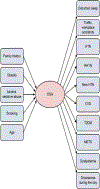Obstructive sleep apnea, hypertension, resistant hypertension and cardiovascular disease
- PMID: 33501418
- PMCID: PMC7830712
Obstructive sleep apnea, hypertension, resistant hypertension and cardiovascular disease
Abstract
Obstructive sleep apnea (OSA) is one of the most common causes of hypertension (HTN) and cardiovascular disease (CVD). It is also a quite common underlying factor in resistant HTN (RHTN). The main etiological factor of OSA is obesity, which is a rapidly growing global epidemic. To control obesity, patients should be encouraged by health care professionals to lose weight and be educated about weight loss strategies such as lifestyle modifications, which include regular exercise, low-calorie diet, low sodium intake, smoking cessation, and decreased alcohol consumption. This review also emphasizes the importance of screening for OSA as the major underlying cause of essential, and RHTN, which can lead to CVD and can cause end-organ damage. It also stresses the importance of using continuous positive airway pressure (CPAP) and its beneficial effects, along with other antihypertensive regimens, in treating HTN, and RHTN. Treatment with CPAP therapy decreases sympathetic activity, high blood pressure (BP), heart rate, and CVD as well as its associated mortality.
Keywords: cardiovascular disease; continuous positive airway pressure; hypertension; obstructive sleep apnea; resistant hypertension.
Conflict of interest statement
Conflicts of interest The author declares that there are no conflicts of interest.
Figures
References
-
- Oscullo Grace, Sapina-Beltran E, Torres Gerard, et al. The potential role of obstructive sleep apnoea in refractory hypertension. Curr Hypertens Rep. 2019;21(8):57. - PubMed
-
- Ohayon MM, Guilleminault C, Priest RG, et al. Is sleep-disordered breathing an independent risk factor for hypertension in the general population (13,057 subjects)? J Psychosom Res. 2000;48(6):593–601. - PubMed
-
- Floras JS. Hypertension and sleep apnea. Can J Cardiol. 2015;31(7):889– 897. - PubMed
-
- Gonzaga C, Bertolami A, Bertolami M, et al. Obstructive sleep apnea, hypertension and cardiovascular diseases. J Hum Hypertens. 2015;29(12):705–712. - PubMed
Grants and funding
LinkOut - more resources
Full Text Sources



